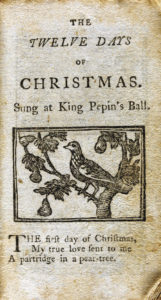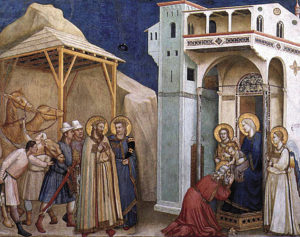The Real Meaning of the 12 Days of Christmas
The Rev. John A.H. Tomoso†
The popular Christmas song “The Twelve Days of Christmas” is actually an English Christmas carol. It grew out of the suppression and persecution of the Catholic Church after the English Reformation. By way of explanation, from 1558 until 1829 Roman Catholics in England were not permitted to practice their faith openly. Someone during that era ingeniously wrote this carol as a catechism song for young Catholics. It has two levels of meaning: the surface meaning, which are the lyrics we know and sing plus a hidden meaning known only to members of the Church. Each element in the carol has a code word for a religious reality which the children and all the faithful could remember.
To begin, the “True Love” one hears in the song is not a boy in love with a girl. It refers to Jesus Christ because truly Love was born on Christmas Day. The one partridge in the pear tree also represents Jesus because that bird is willing to sacrifice its life if necessary to protect its young by feigning injury to draw away predators.
The two turtle doves refer to the Old and New Testaments. Isn’t it interesting to associate doves with the two main parts of the canon of the Bible?
Metaphorically, the doves can refer to Holy Scripture that flies in and around us and even through us, as we read, pray and learn from God’s word.
The three French hens stood for faith, hope, and love. These are great gifts from God with the greatest being love. French hens are really beautiful and they are soft and cuddly and are prized fowl many folk keep as pets. All of God’s gifts are prized and cherished and kept close to the heart.
The four calling birds were the four gospels of Matthew, Mark, Luke, and John. Ah, the Gospels, through which we learn of Jesus, of His life and of His message. So, like birds, the Gospels “fly around in and through us” which allows us to strive to live as Jesus did.

Image: Wikipedia – Mirth without Mischief (1780). London: Printed by J. Davenport, George’s Court
The five golden rings represented the first five books of the Old Testament which describe man’s fall into sin and the great love of God in sending a Savior. The first 5 books of the Old Testament or the “Pentateuch” are known by the Jews as the story of their Covenant with Yahweh (God). As Christians, the Covenant continues through Jesus, God’s Son and our Lord and Savior. Indeed, the story in the Pentateuch of our Salvation is like gold to all of us who know God!
The six geese a-laying stood for the “six days of creation.” And we know that on the seventh day, God rested. Try to live each day anew, like a new egg, laid and ready to be hatched, giving birth to more of the life that God has given us.
The seven swans a-swimming are the seven gifts of the Holy Spirit: Prophesy, Serving, Teaching, Exhortation, Contribution, Leadership, and Mercy. Christians, in their daily life of faith, use these gifts gracefully, like the swans in the lyrics, to keep on their journey to God which is our true destination. It’s like we are swimming towards God at the other end of the pool!
The eight maids a-milking were the eight beatitudes. Beatitude is translated as “supreme blessedness.” So, in the Gospel of Matthew, Chapter 5, verses 3 to 12, it is written:
Blessed are the poor in spirit: for theirs is the kingdom of heaven.
Blessed are the meek: for they shall possess the land.
Blessed are they that mourn: for they shall be comforted.
Blessed are they that hunger and thirst after justice: for they shall have their fill.
Blessed are the merciful: for they shall obtain mercy.
Blessed are the clean of heart: for they shall see God.
Blessed are the peacemakers: for they shall be called children of God.
Blessed are they that suffer persecution for justice’ sake: for theirs is the kingdom of heaven.
Like a calf suckling at its mother’s udder, we derive true sustenance (the milk of our faith) for our daily life, as we journey to God.
Nine ladies dancing were the first nine fruits of the Holy Spirit, of which there are twelve—Charity, Joy, Peace, Patience, Goodness, Mildness, Fidelity, Modesty, Continency [Chastity], plus Forbearance (which is related to Patience), Kindness (which is related to Goodness) and Chastity (which is related to Continency). Can you try, in the New Year, to practice these “fruits?”

Image: Giotto di Bondone – Web Gallery of Art: Image Info about artwork, Public Domain, https://commons.wikimedia.org/w/index.php?curid=3080063
The ten lords a-leaping were the Ten Commandments. You know, whenever I think about the Ten Commandments, I think of that great scene in the movie The Ten Commandments where Moses is coming down from the Mountain of God with the stone tablets. In fact, a part of that scene which is so iconic are dancers carousing among the impatient people. I remember the actor Charleston Heston’s face which went through every emotion as he came down the mountain, ending with surprise and disgust when he saw the dancers. (But not these dancers “a-leaping”; for joy I suppose.)
The eleven pipers piping stood for the eleven faithful Apostles. Can you name them? They all have Feast Days in the church’s liturgical year!
The twelve drummers drumming symbolized the twelve points of belief in The Apostles’ Creed. We recite the Nicene Creed every Sunday at Mass. The Apostles’ Creed is usually recited at the Rites of Baptism, Confirmation, and Ordinations and at the Burial of the Dead. Go ahead and take a look at these and pick out these “twelve points of belief” which we profess, ritually and in our hearts!
Please remember that Advent comes before Christmas but you can start singing this Christmas song right now and through Christmas!
 Rev. John A. Hau’oli Tomoso† is a Social Worker and Episcopal Priest. He is a Priest Associate at Good Shepherd Episcopal Church in Wailuku and an on-call Chaplain at Maui Memorial Medical Center. Tomoso was graduated from St. Anthony Jr./Sr. High School, the College of St. Thomas in St. Paul, Minnesota (Bachelor of Arts in Political Science and Sociology) and Myron B. Thompson School of Social Work at the University of Hawai’i at Mānoa (Masters of Social Work). In 2008, he retired from the civil service as the Maui County Executive on Aging. In March 2019, Tomoso retired as the Executive Director of the non-profit Tri-Isle Resource Conservation and Development Council, Inc., after a social work career that spanned 43 years of practice. His wife Susan recently retired as a 7th grade Language Arts Teacher at Maui Waena Intermediate School.
Rev. John A. Hau’oli Tomoso† is a Social Worker and Episcopal Priest. He is a Priest Associate at Good Shepherd Episcopal Church in Wailuku and an on-call Chaplain at Maui Memorial Medical Center. Tomoso was graduated from St. Anthony Jr./Sr. High School, the College of St. Thomas in St. Paul, Minnesota (Bachelor of Arts in Political Science and Sociology) and Myron B. Thompson School of Social Work at the University of Hawai’i at Mānoa (Masters of Social Work). In 2008, he retired from the civil service as the Maui County Executive on Aging. In March 2019, Tomoso retired as the Executive Director of the non-profit Tri-Isle Resource Conservation and Development Council, Inc., after a social work career that spanned 43 years of practice. His wife Susan recently retired as a 7th grade Language Arts Teacher at Maui Waena Intermediate School.
